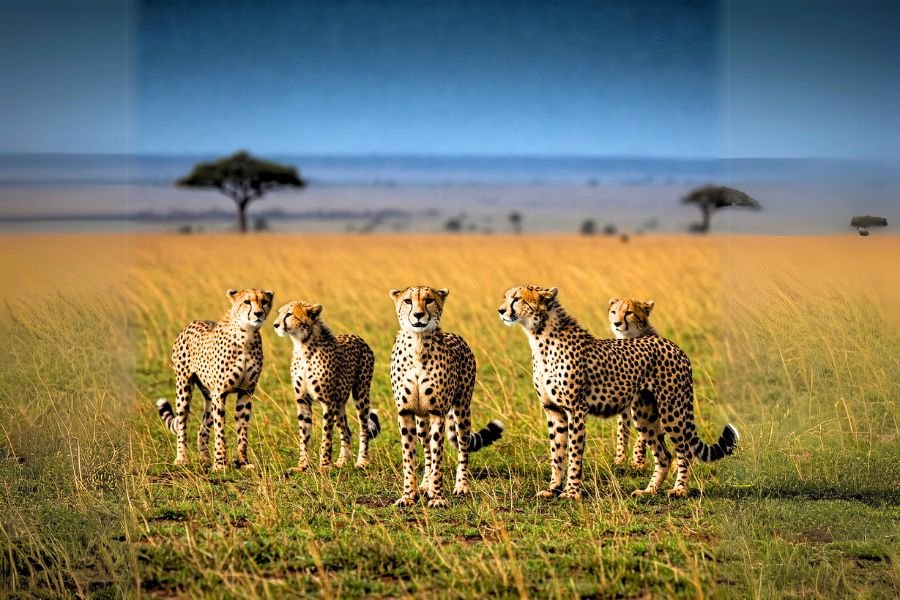The Masai Mara in Kenya hosts some of Africa’s most famous wildlife. Among them, the Tano Bora cheetah coalition gained attention for size, skill, and teamwork. Known as the Magnificent Five, they became a model for understanding male cheetah behavior. Observing them is a highlight of any Masai Mara safari.
A Thrilling Encounter in the Wild
On the Mara’s golden plains, five-spotted cheetahs emerge from tall grass. Safari guides stop vehicles to watch. The cheetahs move together, eyes locked on a herd of gazelles. They sprint with precise timing and capture prey within seconds. Observing the Tano Bora demonstrates rare teamwork. Tourists often cite cheetah sightings as the most memorable part of their visit.
The Rarity of Cheetah Coalitions
Male cheetahs usually live alone or in pairs. Coalitions of five are extremely rare. Groups improve hunting success and defend territory. Tano Bora hunted larger prey and guarded their range. Their cooperation made them a dominant force in the Mara. Guides use them as an example during safari tours.
The Story of Tano Bora
Origins: The Birth of a Brotherhood
Tano Bora was first seen in 2016. Five males from different litters joined in adolescence. Their bond strengthened quickly, forming an unusually large coalition. They named themselves Tano Bora, meaning “The Fantastic Five.” The name reflected their presence and dominance.
Early Challenges: Establishing Dominance
Life in the Mara requires strength. Tano Bora faced rival males and coalitions. Conflicts over territory were frequent. Hunting as a group required coordination. Early hunts involved trial and error. Persistence improved efficiency. They became one of the most successful hunting teams in the Mara.
Hunting Strategies: The Power of Teamwork
The Art of the Hunt
The group used a relay system. One cheetah started the chase while others followed strategically. This prevented prey from escaping. Teamwork increased hunting success. Solitary cheetahs rely on a single sprint, but Tano Bora’s strategy allowed them to take larger prey. Safari visitors often witness these coordinated hunts.
Preferred Prey
Gazelles and impalas were primary targets. Their speed and agility made hunting challenging. Tano Bora also hunted wildebeest calves. Coordinated attacks gave them an advantage. Their method shows how cooperation improves survival.
The Rise to Fame
Tourists and researchers documented their hunts. Photos and videos circulated widely. Wildlife programs featured them on television. The coalition became a symbol of teamwork and hunting skill.
Notable Sightings
In 2018, they killed a fully grown wildebeest. Observers noted their speed and coordination. Such events are rare for cheetahs. These hunts attracted global attention and boosted interest in Masai Mara wildlife tours.
Life in the Mara
Territorial Battles
Tano Bora faced constant competition. Other coalitions and solitary males challenged their territory. Conflicts could become intense. Controlling land gave access to food and mating. Dominance helped them survive.
Breeding Success
Male cheetahs do not raise cubs. Dominant males gain access to multiple females. Some offspring have been seen, continuing the genetic line. Their presence supports the overall cheetah population.
Challenges and Threats
Rival males, habitat loss, and human-wildlife conflict created risks. Disease also threatened survival. Conservationists protect cheetahs and maintain habitats for future visitors.
Why the Tano Bora Coalition Matters
Ecological Significance
Cheetahs maintain balanced ecosystems. They hunt weak or sick animals, keeping prey populations healthy. Their presence influences herbivore movements and grazing. Guides emphasize Tano Bora’s role during tours.
Conservation Importance
Studying Tano Bora provides insight into male cheetah behavior. Understanding coalition dynamics guides wildlife management. Protecting such groups allows future visitors to witness them. Tourism and donations support conservation work.
Best Times and Places to Spot the Tano Bora Coalition
Prime Seasons for Sightings
The dry season, from July to October, is best. Grass is low, and water sources attract prey. Safari guests have higher chances of spotting cheetahs than.
Ideal Locations
The eastern plains, near Talek and Olare Orok Rivers, are prime spots. These areas provide prey and open terrain. Guides recommend these locations for sightings.
Safari Tips
Experienced guides track the coalition’s movements. Early mornings and late afternoons are optimal. Binoculars and cameras increase the chances of witnessing a hunt. Tours often plan trips around these hours.
Current Status and Legacy
Over time, the coalition faced losses. Members died from injuries and fights. By 2025, only Olonyok remains. He continues to roam parts of the Mara. Observing him allows visitors to see the last survivor of the Magnificent Five. Tano Bora’s story teaches lessons about survival, teamwork, and resilience.
The coalition shows how cooperation improves hunting and survival. Their story connects visitors with Mara wildlife and illustrates ecosystem balance.
Conclusion
The Tano Bora coalition represents teamwork, strength, and life in the wild. Observing Olonyok allows visitors to witness the final chapter. Their story highlights survival, cooperation, and the importance of conservation. Guests on a Masai Mara safari can experience the coalition’s legacy through cheetah sightings and guided tours.
